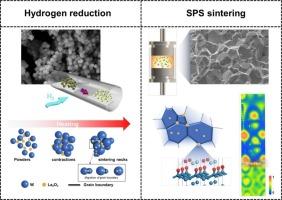Effect of La2O3 addition on preparation of ultrafine tungsten powder and its sintering densification behavior
IF 4.6
2区 工程技术
Q2 ENGINEERING, CHEMICAL
引用次数: 0
Abstract
Tungsten and its alloys occupy a critical position in modern defense, nuclear energy, vacuum electronics, and lighting applications due to their unique and irreplaceable properties. However, the intrinsic brittleness, thermal shock brittleness, and recrystallization brittleness of tungsten significantly limit its application and development. To address the high brittleness and poor strength-toughness of tungsten, the present work aimed to first prepare La2O3 dispersion-strengthened composite powders by spray drying‑hydrogen reduction process. Subsequently, highly dense ultrafine-grained dispersion-strengthened W alloys were fabricated via spark plasma sintering (SPS). It was indicated that La2O3 exhibited a significant refining effect on the powder; however, excessive La2O3 addition led to aggregation, promoting the chemical vapor transport (CVT) mechanism and ultimately causing powder coarsening. During the sintering process, the uneven distribution and aggregation of secondary phase particles diminished their grain refinement capability. The resulting nanostructured W-0.5La2O3 (wt%) composite powder exhibited a grain size of 109 nm, while the W-0.5La2O3 alloy possessed the highest Vickers hardness of 647.9 HV0.2. Furthermore, the reduction and densification mechanisms of composite powder were investigated in detail.

La2O3对超细钨粉制备及其烧结致密化性能的影响
钨及其合金以其独特的、不可替代的性能,在现代国防、核能、真空电子、照明等领域占有重要地位。然而,钨的固有脆性、热冲击脆性和再结晶脆性极大地限制了其应用和发展。针对钨材料脆性高、强韧性差的问题,本文首先采用喷雾干燥-氢还原法制备La2O3分散增强复合粉体。随后,采用火花等离子烧结(SPS)法制备了高密度超细晶弥散强化W合金。结果表明,La2O3对粉末有明显的细化作用;而过量的La2O3加入会导致团聚,促进化学气相传递(CVT)机制,最终导致粉末粗化。在烧结过程中,二次相颗粒的不均匀分布和聚集降低了其晶粒细化能力。制备的W-0.5La2O3 (wt%)纳米复合粉末的晶粒尺寸为109 nm,而W-0.5La2O3合金的维氏硬度最高,为647.9 HV0.2。进一步研究了复合粉末的还原和致密化机理。
本文章由计算机程序翻译,如有差异,请以英文原文为准。
求助全文
约1分钟内获得全文
求助全文
来源期刊

Powder Technology
工程技术-工程:化工
CiteScore
9.90
自引率
15.40%
发文量
1047
审稿时长
46 days
期刊介绍:
Powder Technology is an International Journal on the Science and Technology of Wet and Dry Particulate Systems. Powder Technology publishes papers on all aspects of the formation of particles and their characterisation and on the study of systems containing particulate solids. No limitation is imposed on the size of the particles, which may range from nanometre scale, as in pigments or aerosols, to that of mined or quarried materials. The following list of topics is not intended to be comprehensive, but rather to indicate typical subjects which fall within the scope of the journal's interests:
Formation and synthesis of particles by precipitation and other methods.
Modification of particles by agglomeration, coating, comminution and attrition.
Characterisation of the size, shape, surface area, pore structure and strength of particles and agglomerates (including the origins and effects of inter particle forces).
Packing, failure, flow and permeability of assemblies of particles.
Particle-particle interactions and suspension rheology.
Handling and processing operations such as slurry flow, fluidization, pneumatic conveying.
Interactions between particles and their environment, including delivery of particulate products to the body.
Applications of particle technology in production of pharmaceuticals, chemicals, foods, pigments, structural, and functional materials and in environmental and energy related matters.
For materials-oriented contributions we are looking for articles revealing the effect of particle/powder characteristics (size, morphology and composition, in that order) on material performance or functionality and, ideally, comparison to any industrial standard.
 求助内容:
求助内容: 应助结果提醒方式:
应助结果提醒方式:


